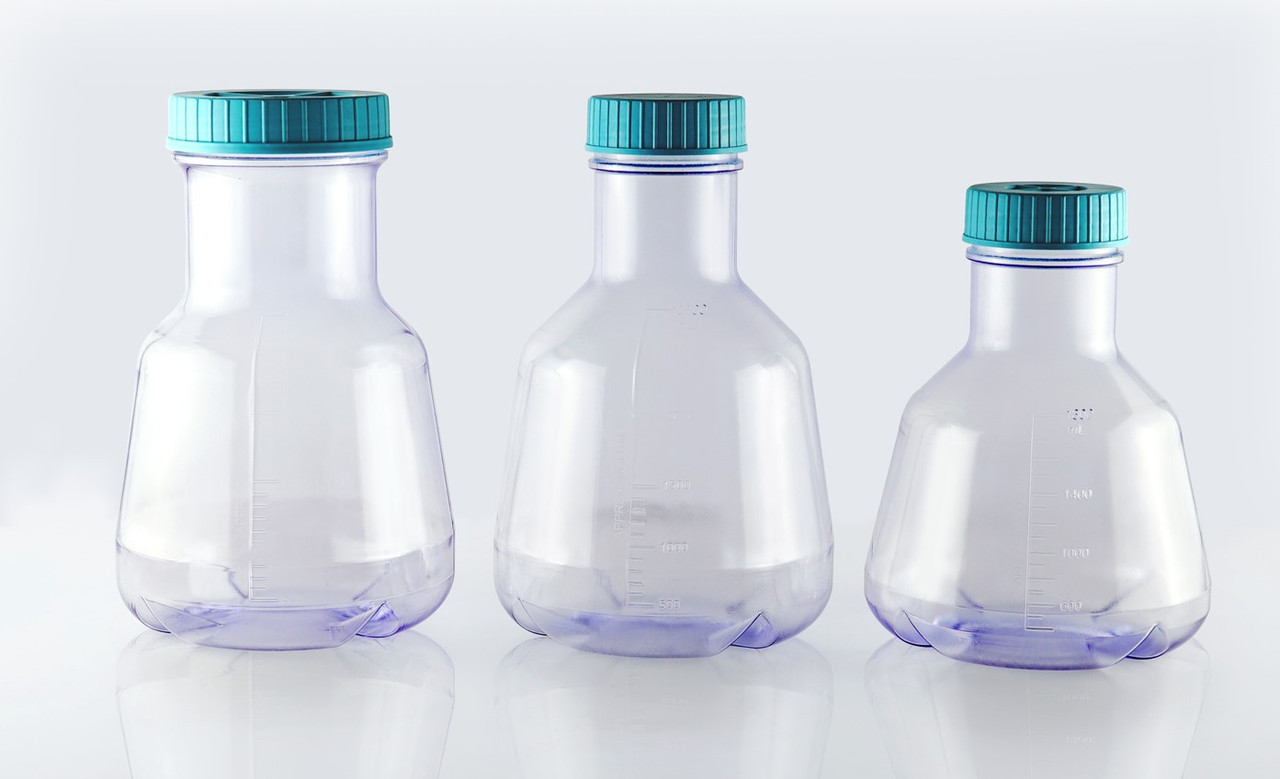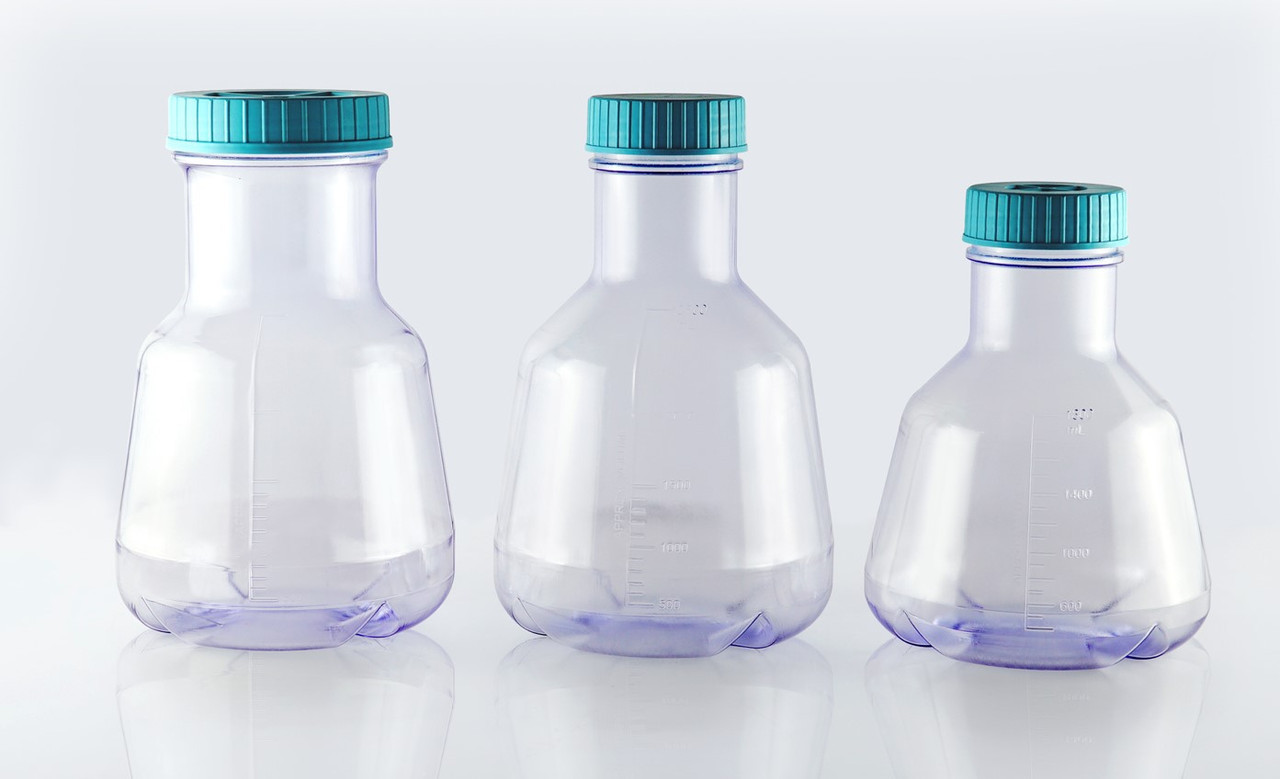Here’s History, Background, and Features
Erlenmeyer flasks are an essential piece of equipment in chemistry and microbiology laboratories. The Erlenmeyer flask was invented in 1891 by the German Organic Chemist Emil Erlenmeyer for the mixing and heating of liquids (1).
Baffled, disposable flasks like the ones pictured above are a popular choice for culture experiments where extra aeration is needed.
Today, they can be found in use in biotech and pharmaceuticals for the growth of bacterial cultures, the production of recombinant proteins, and more.
What is an Erlenmeyer Flask used for?
Erlenmeyer flasks are first and foremost an organic chemistry tool, which is why they have a long neck for spill prevention, and a wide circular base for stirring of solutions.
An Erlenmeyer looks like, but is not to be confused with, a distillation flask or a round-bottomed flask.
Here’s a handy cheat sheet for telling them apart:
Does it have a stem attached to the neck so that it can evaporate liquids while stoppered? That’s a distillation flask, not an Erlenmeyer.
Does it have a round bottom instead of a flat bottom? That is a round bottomed flask, and these are used specifically for boiling solutions.
What is the difference between PETG and Polycarbonate?
Glass is the gold standard in labs, but as you may have guessed, there are different types of plastic material available these days. So when do you opt for plastic, and what kind?
Glass is a good choice if you will be mixing solutions on a hot plate or autoclaving frequently. Polycarbonate can be used in high heat conditions such as autoclaving, but it’s more fragile than PETG and may shatter or crack if exposed to physical stress.
If you are worried about fragility, PETG may be your first pick. PETG tends to be used for disposables and just isn’t ideal if you are heating the flask contents.
Baffled-Bottom Flasks
Baffled flasks have convolutions on the bottom like a plastic soda bottle. They may not look very important, but what they do is increase the oxygen exchange rate inside of solutions stored within the flask. This is useful when cultures require extra aeration.
Baffles are still a relatively new topic in shaker culture research (2), and not everything about them is well understood, but the point of their structure is to create wavelike undulations and avoid sedimentation.
Narrow-Mouth Erlenmeyer Flasks vs. Wide-Mouth Flasks
Erlenmeyers may come with either narrow-size or wide mouth tops. Wide mouths make pipette mixing and the addition of other components easier. Flasks may always be stopped and saved. Modern suppliers usually sell ones with screw caps included.
What do I Need to Worry About with Erlenmeyer Flasks?
Like all glassware, Erlenmeyer flasks come with their own set of concerns. They are not measuring devices– the measurement notches on the side are for general reference because they are made with roughly 5% uncertainty, no less.
Despite being intended for the heating and mixing of solutions, these flasks can crack or shatter in very high heats, or when used to contain harsh chemicals. Knowing the difference between Class A and Class B containers can prevent accidents.
Safety Precautions for Working with Flasks
- Always wear gloves while handling.
- Hold them near the neck, and use a c-fold napkin or thermal gloves if not cool.
- Make sure any volatiles are kept covered and under a fume hood.
- Do not fill containers beyond their highest gradation and watch levels if they are being heated to prevent spills.
Baffled flasks pose their own challenge because the baffles can lead to complications when estimating oxygen transfer rate and making other calculations (2).
Some scientists choose to improve reproducibility by using flasks from one lot number for their experiments.
However complicated the math, baffles can help a lot with preventing sedimentation and increasing aeration, so it’s worth the trouble if you need them for your research.
Tri-Bio Plastic Erlenmeyer Flasks and Globe Glass
Stellar Scientific features an affordable in-house line of PETG and polycarbonate flasks for your microbiology needs. See our entire catalog of Tri-Bio plastic Erlenmeyer flasks for all of the sizes and pricing we have available.
Our Tri-Bio plastics are single-use disposables that include their own vented lid with a 0.22um hydrophobic filter to prevent contamination in your work without preventing proper ventilation of your cultures.
We offer baffled flasks and the traditional flat bottomed ones, depending on your need. All are gamma-irradiated and DNASE/RNASE free in sterile-packed cases that are available in several bulk sizes.
Would you prefer a reusable option? Stellar Scientific also carries Globe glass borosilicate Erlenmeyer flasks for heating, autoclaving, and mixing liquids.
Globe glass Erlenmeyers come in a range of sizes from 25ml up to 2L and offer wide mouth and narrow mouth options. All Globe glassware meets ASTM E1404 general laboratory standards.
Stellar Scientific also houses many other options. See our full catalog for more lab glassware and plastic shaker flasks. If you need any help finding a specific item or accessory, don’t hesitate to use the chat or email to reach out!
Footnotes:
____________________________________________
- Helmenstine, Todd. “Erlenmeyer Flask.” Science Notes, 27 June 2014, sciencenotes.org/today-science-history-june-28/.
- Meier, K., Klöckner, W., Bonhage, B., Antonov, E., Regestein, L., & Büchs, J. (2016). Correlation for the maximum oxygen transfer capacity in shake flasks for a wide range of operating conditions and for different culture media. Biochemical Engineering Journal. V 109, 228-235. https://doi.org/10.1016/j.bej.2016.01.014.
3. Zhao, L., Wang, B., Armenante, P. M., Conmy, R., & Boufadel, M. C. (2016). Characterization of Turbulent Properties in the EPA Baffled Flask for Dispersion Effectiveness Testing. Journal of environmental engineering (New York, N.Y.), 142(1), 1–14. https://doi.org/10.1061/(ASCE)EE.1943-7870.000100...


